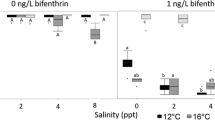Abstract
Bioaccumulation and toxicity tests using benthic invertebrates such as the estuarine amphipod Leptocheirus plumulosus are typically used to assess the ecological risk associated with contaminated sediments. Despite their ecological and regulatory importance, little is known about such species at the genetic level. To begin understanding cellular and genetic responses of L. plumulosus to contaminants, we isolated several of their genes and developed quantitative assays to measure the effects of water exposures to 2, 4, 6-trinitrotoluene and phenanthrene on gene expression. Real-time polymerase chain reaction (PCR) assays demonstrated that the expression of the genes for actin and a retrotransposon, hopper, was dependent on the exposure and tissue concentrations of those chemicals. Our data suggests that exposure to the explosive 2, 4, 6-trinitrotoluene and phenanthrene may induce movement of hopper resulting in unexpected genotoxic results.
Similar content being viewed by others
References
Bustin, S.A. (2000). Absolute quantification of mRNA using realtime reverse transcription polymerase chain reaction assays. J. Mol. Endocrinol. 25(2), 169-93.
Emery, V.L. Jr., Moore, D.W., Gray, B.R., Duke, B.M., Gibson, A.B., Wright, R.B. and Farrar, J.D. (1997). Development of a chronic sublethal sediment bioassay using the estuarine amphipod Leptocheirus plumulosus (Shoemaker). Environ. Toxic. Chem. 16, 1912-20.
Gahan, L.J., Gould, F. and Heckel, D.G. (2001). Identification of a gene associated with Bt resistance in Heliothis virescens. Science 293, 857-60.
Gray, B.R., Emery, V.L., Brandon, D.L., Wright, R.B., Duke, B.M., Farrar, J.D. and Moore, D.W. (1998). Selection of optimal measures of growth and reproduction for the sublethal Leptocheirus plumulosus sediment bioassay. Environ. Tox. Chem. 17, 2288-97.
Green, A., Moore, D. and Farrar, D. (1999). Chronic toxicity of 2,4,6-trinitrotoluene to a marine polychaete and an estuarine amphipod. Environ. Tox. Chem. 18, 1783-90.
Hagan, C.R. and Rudin, C.M. (2002). Mobile genetic element activation and genotoxic cancer therapy: potential clinical implications. Am. J. Pharmacogenomics 2, 25-35.
Mathias, S.L. and Scott, A.F. (1993). Promoter binding proteins of an active human L1 retrotransposon. Biochem. Biophys. Res. Commun. 191, 625-32.
Miki, Y., Nishisho, I., Horii, A., Miyoshi, Y., Utsunomiya, J., Kinzler, K.W., Vogelstein, B. and Nakamura, Y. (1992). Disruption of the APC gene by a retrotransposal insertion of L1 sequence in a colon cancer. Cancer Res. 52, 643-5.
Morrish, T.A., Gilbert, N., Myers, J.S., Vincent, B.J., Stamato, T.D., Taccioli, G.E., Batzer, M.A. and Moran, J.V. (2002). DNA repair mediated by endonuclease-independent LINE-1 retrotransposition. Nat. Genet. 31, 159-65.
Speek, M. (2001). Antisense promoter of human L1 retrotransposon drives transcription of adjacent cellular genes. Mol. Cell. Biol. 21, 1973-85.
Stuart, R.O., Bush, K.T. and Nigam, S.K. (2001). Changes in global gene expression patterns during development and maturation of the rat kidney. Proc. Natl. Acad. Sci. USA 98, 5649-54.
Teng, S.C., Kim, B. and Gabriel, A. (1996). Retrotransposon reverse-transcriptase-mediated repair of chromosomal breaks. Nature 383, 641-4.
Tremblay, A., Jasin, M. and Chartrand, P. (2000). A double-strand break in a chromosomal LINE element can be repaired by gene conversion with various endogenous LINE elements in mouse cells. Mol. Cell. Biol. 20, 54-60.
USEPA (2001). Method for assessing the chronic toxicity of marine and estuaruine sediment-associated contaminants with the amphipod Leptocheirus plumulosus, EPA 600/R-01/020, US Environmental Protection Agency and the US Army Corps of Engineers: Washington, DC.
USEPA/USACE (1998). Evaluation of dredged material proposed for discharge in waters of the US testing manual, EPA-823-B-004, US Environmental Protection Agency and the US Army Corps of Engineers: Washington, DC.
Zhao, D. and Bownes, M. (1998). The RNA product of the Doc retrotransposon is localized on the Drosophila oocyte cytoskeleton. Mol. Gen. Genet. 257, 497-504.
Author information
Authors and Affiliations
Corresponding author
Rights and permissions
About this article
Cite this article
Perkins, E.J., Lotufo, G.R. Playing in the Mud-Using Gene Expression to Assess Contaminant Effects on Sediment Dwelling Invertebrates. Ecotoxicology 12, 453–456 (2003). https://doi.org/10.1023/B:ECTX.0000003029.70980.2f
Issue Date:
DOI: https://doi.org/10.1023/B:ECTX.0000003029.70980.2f




